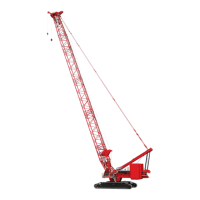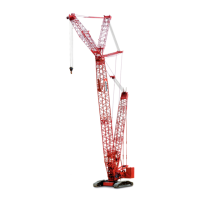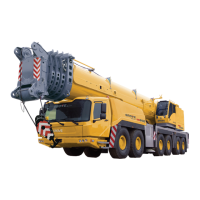Lubrication Guide MLC300
F2280-4
Published 07-21-21
between wires and strands. This buildup will inhibit rope
inspection and could trap moisture in the rope’s interior.
A high-quality wire rope lubricant is available from the
Manitowoc Crane Care Lattice Team.
CYLINDER ROD LUBRICATION
General
The cylinder rods on Manitowoc cranes have a layer of
chrome plating on their surfaces to help protect them from
corrosion.
However, the chrome plating has cracks in its structure which
can allow moisture to corrode underlying steel. Depending
on ambient temperature and the frequency of cylinder
operation, the crane’s hydraulic oil may not penetrate these
cracks and protect the rods. Even if the cylinders are
operated on a regular basis, many cylinders have portions of
exposed rod even when the cylinders are fully retracted.
Exposed cylinder rods on cranes that are stored,
transported, or used in inclement environments (high
humidity, rain, snow, and salt air) are at a high risk of
corrosion.
Protecting Cylinder Rods
All exposed cylinder rods must be protected by applying a
thorough coat of cylinder-rod protectant available from
Manitowoc in 12 oz. aerosol cans—order part number
9999101803.
The cylinder-rod protectant contains solvents and lubricants
that penetrate metal pores, displace moisture, dissolve
existing corrosion, and then dry to a resilient waxy coating.
Cylinder operation and weather will remove the protectant
over time. Therefore, inspect all cylinder rods weekly and
reapply protectant to exposed rods.
HYDRAULIC QUICK DISCONNECT
LUBRICATION
All hydraulic quick disconnects must be protected by
applying LPS-2 Aerosol Lubricant. Lubricant must be applied
while connecting and disconnecting the hydraulic quick
disconnects during crane assembly and disassembly.
1. All Quick Disconnects must be fully screwed together
until there is metal to metal contact during crane
assembly.
2. All plugs, regardless of location, must be fully screwed
together into their corresponding caps until there is
metal to metal contact during crane assembly.
Examples of locations of caps and plugs:
• hanging lanyards
• storage brackets
• job box
3. All Quick Disconnects must be fully screwed together
with their corresponding cap and plug until there is metal
to metal contact during crane disassembly.
The following threaded areas of the quick disconnects, caps,
and plugs must be lubricated during crane assembly and
disassembly (see Figure 3
):
• threaded surface of male quick disconnect
• threaded surface of female quick disconnect
• threaded surface of aluminum caps and plugs
• o-rings
NOTE If the crane is stored without operating for long
duration, the hydraulic quick disconnects, caps,
and plugs must be lubricated every 6 months.
FIGURE 3
Item Description
1 Female Quick Disconnect
2 Male Quick Disconnect
3 O-ring
4 Aluminum Cap
5 Aluminum Plug

